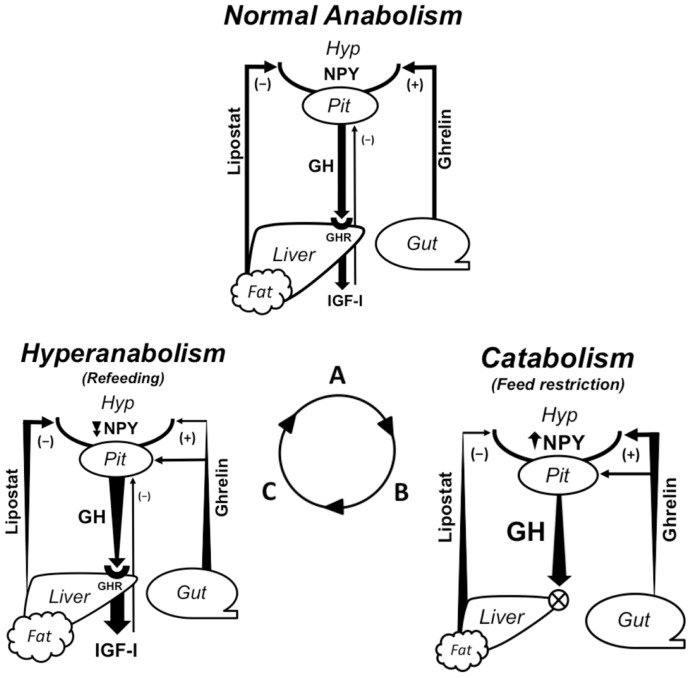Figure 2.
Endocrine regulation of growth and appetite during normal anabolism, catabolism, and hyperanabolism (CG) resulting from feeding status. Growth is regulated by the GH/IGF axis; GH secreted into circulation by the pituitary binds its receptor (GHR) to stimulate hepatic IGF-I production, which systemically drives somatic growth and exerts negative feedback on GH secretion. Lipolysis is an alternate function of GH during catabolism. Peripheral signals from a lipostatic mechanism (anorexigenic), possibly leptin, and ghrelin (orexigenic) regulate energy intake by modulating NPY and other neuropeptides in the central feeding center. Ghrelin also functions as a GH secretagogue. Arrows show the direction of regulatory pathways; widening/narrowing of arrows represents a dynamic increase/decrease in a component over the duration of a particular metabolic state. (A) During regular feeding, energy homeostasis is maintained by matching energy intake and expenditure. Peripheral signals counter-regulate appetite centrally. Growth is regulated by nominal levels of circulating GH, which stimulates IGF-I production via hepatic GHRs. (B) Fasting necessitates catabolic processes to provide energy for basal metabolism. Rising ghrelin production stimulates both appetite and circulating GH levels. Elevated lipolytic GH levels exploit stored energy reserves, decreasing lipostatic signaling. Reduced hepatic GHR expression desensitizes the liver to GH-induced IGF-I production. (C) Refeeding signifies the switch from catabolic to anabolic processes. Temporally elevated orexigens carried over from fasting drive hyperphagia. The return to positive energy status is characterized by the resumption of hepatic GH sensitivity and a steep rise in circulating IGF-I levels, which promotes accelerated growth. Eventually, the repletion of energy reserves and negative feedback from IGF-I returns GH and appetite to nominal levels, marking the return to normal growth rates. (PIT, pituitary; HYP, hypothalamus; NPY, neuropeptide Y; GH, growth hormone; GHR, growth hormone receptor; IGF-I, insulin-like growth factor I).

